iD&D: Dice Rollers Part 1
In this, our second month of iD&D, we jump into the golden standard of pen and paper RPGs: Dice.
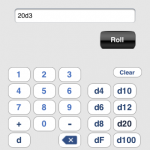
Welcome, readers, to another edition of iD&D. Last month we took an epic journey through the inner workings of the app store map power house, Battle Map. Our review took readers through the powerful tools that Battle Map offers, and showed the versatility of customization and real time interaction through the external monitor options. Check out the newest update for Battle Map in the app store now.
This month, we’re taking a dip into the wide world of dice rollers. They come in all shapes and sizes, from bare bones options to the extremely customizable and programmable options. There are tons of dice rollers out there, so we’ve decided to take a closer look at 3 different apps this month, three different apps next month, and provide a comparative analysis of each of these 6 apps. Well, I’m “die”ing to get into this month’s article so let’s jump right in.
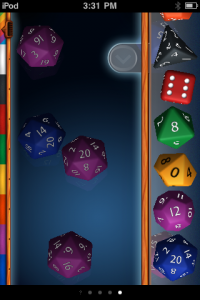
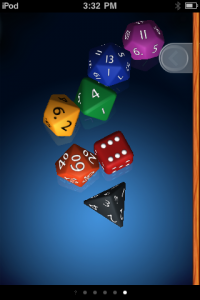 Pip, from Mystery Coconut Games, offers beauty in a simplistic package. Pip is, simply put, a dice roller. Pip includes the standard 7 dice that are required in a d20 game: d20, d12, d10, d8, d6, d4, and a percentile. These are dragged onto the “table” from a side menu showing each of the 7 dice. Only the color is customizable. It’s like having a dice bag filled with as many of the standard 7 as you could ever need.
Pip, from Mystery Coconut Games, offers beauty in a simplistic package. Pip is, simply put, a dice roller. Pip includes the standard 7 dice that are required in a d20 game: d20, d12, d10, d8, d6, d4, and a percentile. These are dragged onto the “table” from a side menu showing each of the 7 dice. Only the color is customizable. It’s like having a dice bag filled with as many of the standard 7 as you could ever need.
Pip uses an actual table that is rolled by shaking the iPod or iPhone. The physics engine powering Pip does a great job of emulating the actual movement that dice would make if shaken in a specific way. Pip offers multiple tables as well. These tables can be scrolled through with a swipe of the finger, offering some versatility in its simplicity.
Who Pip is for: Pip shines at the basic users must have dice roller. Its basic design and intuitive control structure make it an absolute asset in games. Who Pip is not for: Pip isn’t for a complex player looking to calculate complex equations in a single roll. There is no “d20-4” options, so you’ll be doing your own math if you use Pip. Issues: Pip’s drag and drop display is somewhat cut off on my 3rd gen iPod, making it difficult (but not impossible) to drag the percentile from the menu to the table. Recommendation: If you’re looking for a simplistic dice roller, you cannot find a better option than Pip. Side Note: In case you were not aware, a pip is the dot usually found on 6 sided dice that come with games such as monopoly. True to its name, Pip (the app) keeps the dots on 6 sided die. Good show!
Update: The tab button that hides and shows the dice panel can actually be dragged up and down, showing access to fudge and average dice, as well as a delete all button. With the additional dice options and the ability to scroll through the dice, my main issue with Pip is cleared up. Thanks to Coconut Games for clearing that up for me.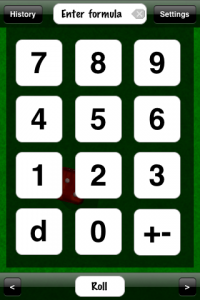
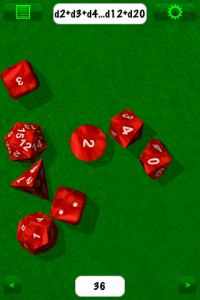 Mach Dice takes the general ideas evident within Pip, and splashes in a few additional options. Graphically Mach Dice is a bit less appealing, though respectable in its own right. It’s the options that really help set Mach Dice up as the next step in dice rolling needs. Aesthetic options such as d6 edges, numerical or pip display, and background colors are mixed in with such utilization options like tilt and shake sensitivity, labels on d10 and d3 (Fudge or standard), and how the physics work.
Mach Dice takes the general ideas evident within Pip, and splashes in a few additional options. Graphically Mach Dice is a bit less appealing, though respectable in its own right. It’s the options that really help set Mach Dice up as the next step in dice rolling needs. Aesthetic options such as d6 edges, numerical or pip display, and background colors are mixed in with such utilization options like tilt and shake sensitivity, labels on d10 and d3 (Fudge or standard), and how the physics work.
Perhaps the key difference between Pip and Mach Dice is the ability for Mach Dice to add variables into the equation. A very basic screen can be brought up allowing for d(variable) to be added or subtracted from ability scores, etc. or from other d(variable) rolls. Mach Dice offers five different tables, with differing backgrounds and arrows to scroll between. Each table can have a different set of dice on it, and a history list shows a seemingly endless set of previous rolls.
Who Mach Dice is for: The users who need a little more versatility than Pip, while being ok with a step down in graphical design. The inclusion of the variable sided die with added modifiers is a big jump from Pip. FUDGE gamers will find the required dice in Mach Dice’s options. Who Mach Dice is not for: With added features comes added interaction. Where Pip has a simple drag and drop interface, Mach Dice requires equations to be input into the system to work properly. Issues: Changing the color of dice is somewhat forced into the input screen. It’s an extremely distracting method to change the color of dice. Also, I’ve had instances where one of the tables come up without any graphics at all, and I can only see the top and bottom interface bars. Recommendation: Mach Dice isn’t as crisp an experience as Pip, but still offers additional versatility without sacrificing simplicity. It’s an extremely cheap option at $0.99, and really is a great choice for the individual looking to gain an added level of customization. It’s by far the simple option for any Do-It-Yourself Gaming System (FUDGE) gamer. Side Note: The developer recently updated Mach Dice to include the FUDGE dice, and based on his blog posting on his website, plans at least a few additional updates in the future. Support = Win!
 Quick Roll is the first feature powerhouse app on the list, and is dangerously close to becoming my must have companion for all of my gaming adventures. Quick Roll throws the graphical representation of Pip and Mach Dice out the window, and frankly I think it’s a great decision. Five tabs separate the different screens available in Quick Roll including a pre-programmable roll tab, an attack tab, a roll history tab, a profile tab, and a free form tab. These features work together to make a truly winning app.
Quick Roll is the first feature powerhouse app on the list, and is dangerously close to becoming my must have companion for all of my gaming adventures. Quick Roll throws the graphical representation of Pip and Mach Dice out the window, and frankly I think it’s a great decision. Five tabs separate the different screens available in Quick Roll including a pre-programmable roll tab, an attack tab, a roll history tab, a profile tab, and a free form tab. These features work together to make a truly winning app.
Who Quick Roll is for: Quick Roll is for the guy with multiple characters, multiple rolls, complicated character sheets, and a need to get everything under one nice umbrella app. Who Quick Roll is not for: Quick Roll steps out of the realm of graphics and into the realm of power. It’s a lot of versatility, and if you can’t see yourself using it to its full potential, I would recommend sticking with a lighter roller. Issues: The attack tab is good in theory, but is limited in customization making it difficult to use for people with multiple attacks w/ differing damage rolls. Recommendation: Quick Roll provides me with everything I need, without offering me things I don’t. It’s not pretty, it doesn’t have a physics engine or a nice graphical roller, but it fits my needs. If you need power without beauty, get Quick Roll. Its slick design will keep you happy for a long time. Side Note: Quick Roll takes a lot of up-front work, especially if you
Next month we will conclude our two part special on Dice Rollers. We will be taking a look at Multi Dice Roller, RPG Calc, and the powerhouse Dicenomicon.
Is there a dice roller that you use that's not on this list? Let us know what it is? What do you like about it? How does it compare to the above apps?

